Post by garbulky on Jul 1, 2017 13:24:03 GMT -5
If anybody has been following my somewhat fruitless quest to find an affordable dedicated digital transport ...here it is!
Windows 10 driver can be found here! : Musiland Digital Times Windows 10 64 bit driver can be found here.
(maybe) www-old.musiland.cn/index.php/Download/get_file/id/75
^^The above was reported by another user. I was able to get it from here www.musiland.cn/index.php/Download/get_file/id/75 but it looks like that URL is expired.
Note: I wasn't interested in USB to AES/BNC/I2S as an interface. Because it then has to travel through a USB port. No thanks. Why wouldn't I just go direct USB to USB then? However if anybody is interested in that a forum member reccomended this one.
www.shenzhenaudio.com/singxer-su-1-usb-digital-interface-with-xmos-xu208-cpld-dsd256-dop.html
I wanted a dedicated PCI express solution.
The only ones I could find were the RME type pro sound cards.
This had two issues.
1. They were expensive. $300-800.
2. The AES outputs were 32 channel huge breakout cables. These were obviously designed for pro use and not really for a 2 chanel enthusiast like me. I wanted a dedicated 2 channel solution. Not a 32 channel transport.
Now this is ridiculous that with all the audiophiles out there that use a PC as their source and all the DACs out there with all this fancy I2s, BNC, AES, the onyl solutions to get these connected through their native dedicated interfaces are USB INTERFACE CARDS. Why?!? It's not like this type of thing should be hard to design?! Most of these outputs have been around for ages. Just slap on a fancy clock or something, some marketting buzzwords and sell these for a huge markup and profit. But apparently nobody has exploited this niche.
So enter Musiland Digital Times BNC SPDIF PCI card!
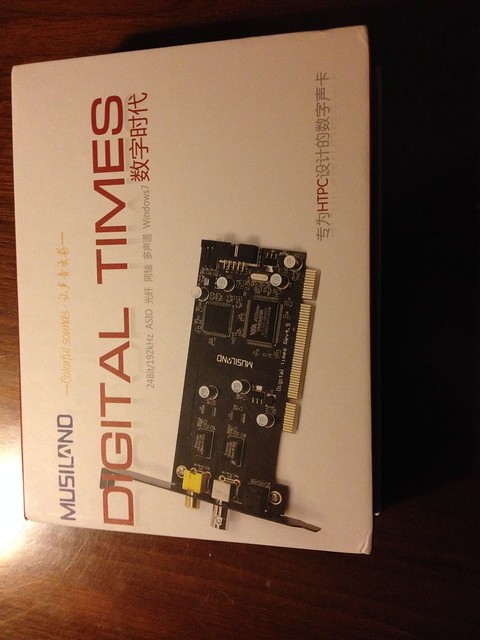
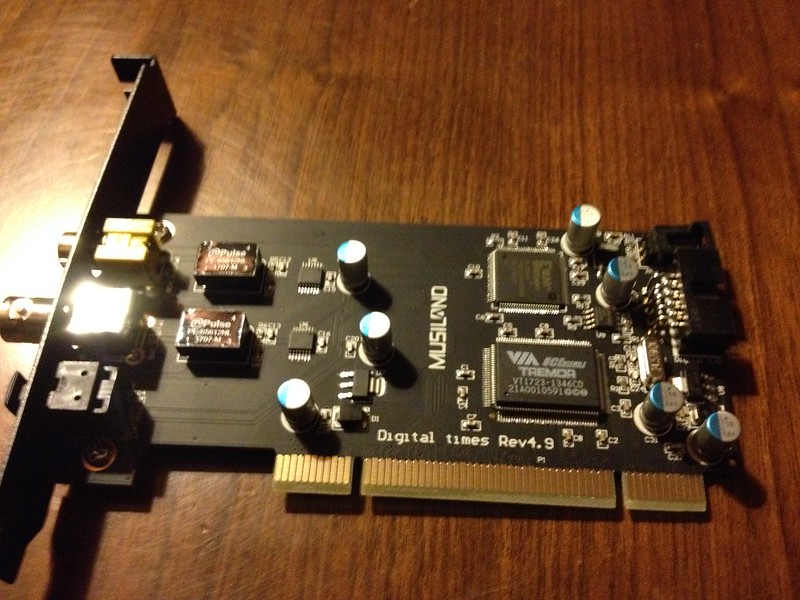
BNC dedicated output!
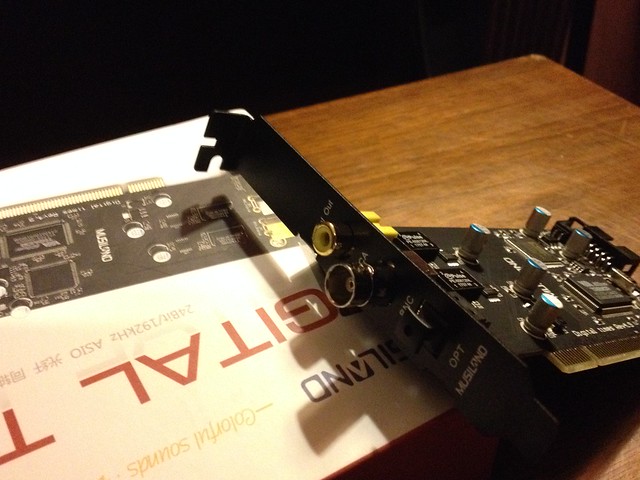
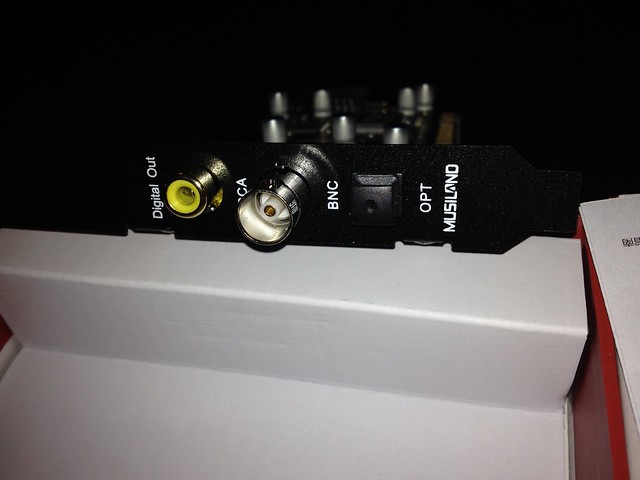
Musiland Digital Times Windows 10 64 bit driver can be found here.
www.musiland.cn/index.php/Download/get_file/id/75
I know anybody with this card will find it hard to figure out where to find it. But there it is ^^
This card doesn't require a dedicated power connection like the Asus Xonar Essence ST which is my normal solution. I'm a little split by that decision to not use a dedicated power connection.It has a slightly lower SNR at 112 db. Edit: I made a mistake. It has a great 140 db SNR.
it also clearly doesn't take as much power. The Xonar is a multi purpose headphone amp, digital transport, 2 channel and even support for a multichannel daughter card. Quite an impressive card imo. It didn't really mess around with sound quality. It also had the advantage of having a dedicated "jitter" clock whatever that means. So the Digital Times was going to be up against some stiff competition. Asus really spent their time engineering their card.
The Musiland Digital Times card uses some type of FPGA and an Envy 24 controller to output its digital audio.
After finally finding the driver, the install went fine and it worked fine without hiccups.
The latency on this card for videos was pretty good with the voices syncing with the video very well. If anybody has watched music videos you'll know that great latency helps a lot to create an immersion with people's lips moving on screen.
I connected it using a 75 ohm 6 foot el cheapo BNC cable. All I cared was that this BNC cable met the 75 ohm spec standard of the DC-1.
So how is the sound quality?
Honestly...I don't notice a remarkable improvement. It seems to do its job. The soundstage felt seamless left to right. Etc.
Trying out "Many Rivers to Cross" a free download on Linn records in 24 bit 192 khz, I found no significant difference that jumped out at me.
Bass feels defined. Honestly there's not much difference if at all. I compared to the Asus Xonar Essence ST and the Sony BDP 5100 blu ray players digital RCA output.
Now its driver software has something that I find rather interesting.
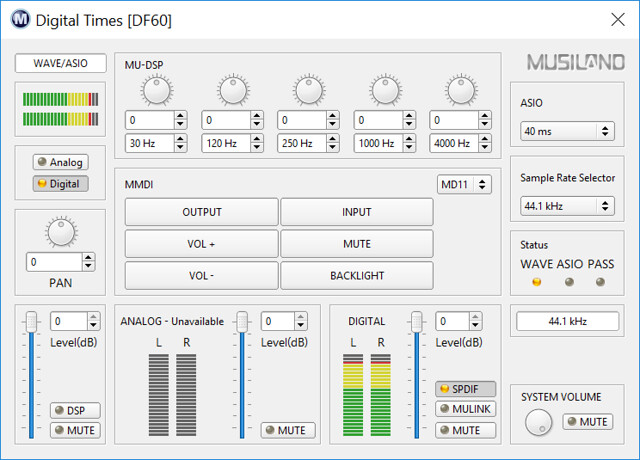
First it is completely bloat free of fancy interfaces. The whole driver was 14 MB. This is a contrast to the Xonar essence interface which though not technically bloated and functional simply looked ugly to me.
Other than being able to manually enter exact levels for pan and volume. There is an indicator that shows when ASIO is enabled. But the most interesting is the thing called MU-DSP basically an equalizer. It has five bands.....but you can specify exactly which frequencies you want to boost and cut. So I thought that was neat. But since I hate all things equalizer, I turned it off. But some playing around did show that it made some minor differences to the sound which weren't half bad. Like a little customizable bass boost of sorts. Of note the Essence also has an equalizer but the frequency selection is fixed. Also the steps on the digital times was a lot finer in resolution than that of the xonar.
I do which I knew what MMDI, MD11, MD30 and MU-DSP meant.
The ASIO connection allows you to specify latency all the way down to 5 ms which I guess is quite something? I don't know, I don't use ASIO.
To my surprise, WASAPI MODE WORKS WITH this card. Not only does WASAPI Event work ....but so does Wasapi push! The passthrough light lights up when WASAPI is engaged on the control panel. WASAPI support was not advertised and that was my hesitancy in selecting it. Well there you go. WASAPI works fine. Foobar works fine. Pretty much everything you expect works fine.
It did sound better than USB asynchronous to the DC-1. Not by a lot, subtle. I'd put it on close footing as the Asus Xonar Essence ST and also my Sony BDP 5100 blu ray player.
So there you go. The card cost me about $65. The sound quality is fine. It is a dedicated digital transport has three digital outputs RCA, BNC, and Optical. For the price it's pretty nice. Nothing stood out with it for me. I wasn't wowed by anything it did different. But it did the job. The price was right and you can use your BNC input on your DC-1.
Windows 10 driver can be found here! : Musiland Digital Times Windows 10 64 bit driver can be found here.
(maybe) www-old.musiland.cn/index.php/Download/get_file/id/75
^^The above was reported by another user. I was able to get it from here www.musiland.cn/index.php/Download/get_file/id/75 but it looks like that URL is expired.
Note: I wasn't interested in USB to AES/BNC/I2S as an interface. Because it then has to travel through a USB port. No thanks. Why wouldn't I just go direct USB to USB then? However if anybody is interested in that a forum member reccomended this one.
www.shenzhenaudio.com/singxer-su-1-usb-digital-interface-with-xmos-xu208-cpld-dsd256-dop.html
I wanted a dedicated PCI express solution.
The only ones I could find were the RME type pro sound cards.
This had two issues.
1. They were expensive. $300-800.
2. The AES outputs were 32 channel huge breakout cables. These were obviously designed for pro use and not really for a 2 chanel enthusiast like me. I wanted a dedicated 2 channel solution. Not a 32 channel transport.
Now this is ridiculous that with all the audiophiles out there that use a PC as their source and all the DACs out there with all this fancy I2s, BNC, AES, the onyl solutions to get these connected through their native dedicated interfaces are USB INTERFACE CARDS. Why?!? It's not like this type of thing should be hard to design?! Most of these outputs have been around for ages. Just slap on a fancy clock or something, some marketting buzzwords and sell these for a huge markup and profit. But apparently nobody has exploited this niche.
So enter Musiland Digital Times BNC SPDIF PCI card!


BNC dedicated output!


Musiland Digital Times Windows 10 64 bit driver can be found here.
www.musiland.cn/index.php/Download/get_file/id/75
I know anybody with this card will find it hard to figure out where to find it. But there it is ^^
This card doesn't require a dedicated power connection like the Asus Xonar Essence ST which is my normal solution. I'm a little split by that decision to not use a dedicated power connection.
it also clearly doesn't take as much power. The Xonar is a multi purpose headphone amp, digital transport, 2 channel and even support for a multichannel daughter card. Quite an impressive card imo. It didn't really mess around with sound quality. It also had the advantage of having a dedicated "jitter" clock whatever that means. So the Digital Times was going to be up against some stiff competition. Asus really spent their time engineering their card.
The Musiland Digital Times card uses some type of FPGA and an Envy 24 controller to output its digital audio.
After finally finding the driver, the install went fine and it worked fine without hiccups.
The latency on this card for videos was pretty good with the voices syncing with the video very well. If anybody has watched music videos you'll know that great latency helps a lot to create an immersion with people's lips moving on screen.
I connected it using a 75 ohm 6 foot el cheapo BNC cable. All I cared was that this BNC cable met the 75 ohm spec standard of the DC-1.
So how is the sound quality?
Honestly...I don't notice a remarkable improvement. It seems to do its job. The soundstage felt seamless left to right. Etc.
Trying out "Many Rivers to Cross" a free download on Linn records in 24 bit 192 khz, I found no significant difference that jumped out at me.
Bass feels defined. Honestly there's not much difference if at all. I compared to the Asus Xonar Essence ST and the Sony BDP 5100 blu ray players digital RCA output.
Now its driver software has something that I find rather interesting.

First it is completely bloat free of fancy interfaces. The whole driver was 14 MB. This is a contrast to the Xonar essence interface which though not technically bloated and functional simply looked ugly to me.
Other than being able to manually enter exact levels for pan and volume. There is an indicator that shows when ASIO is enabled. But the most interesting is the thing called MU-DSP basically an equalizer. It has five bands.....but you can specify exactly which frequencies you want to boost and cut. So I thought that was neat. But since I hate all things equalizer, I turned it off. But some playing around did show that it made some minor differences to the sound which weren't half bad. Like a little customizable bass boost of sorts. Of note the Essence also has an equalizer but the frequency selection is fixed. Also the steps on the digital times was a lot finer in resolution than that of the xonar.
I do which I knew what MMDI, MD11, MD30 and MU-DSP meant.
The ASIO connection allows you to specify latency all the way down to 5 ms which I guess is quite something? I don't know, I don't use ASIO.
To my surprise, WASAPI MODE WORKS WITH this card. Not only does WASAPI Event work ....but so does Wasapi push! The passthrough light lights up when WASAPI is engaged on the control panel. WASAPI support was not advertised and that was my hesitancy in selecting it. Well there you go. WASAPI works fine. Foobar works fine. Pretty much everything you expect works fine.
It did sound better than USB asynchronous to the DC-1. Not by a lot, subtle. I'd put it on close footing as the Asus Xonar Essence ST and also my Sony BDP 5100 blu ray player.
So there you go. The card cost me about $65. The sound quality is fine. It is a dedicated digital transport has three digital outputs RCA, BNC, and Optical. For the price it's pretty nice. Nothing stood out with it for me. I wasn't wowed by anything it did different. But it did the job. The price was right and you can use your BNC input on your DC-1.


 No USB for me!
No USB for me! 

 No need for that. We enjoy audio in different ways. Audio transports are obviously not your thing. No need to trash on a thread meant for people interested in audio transports. Something for everybody, ya know?
No need for that. We enjoy audio in different ways. Audio transports are obviously not your thing. No need to trash on a thread meant for people interested in audio transports. Something for everybody, ya know? 
